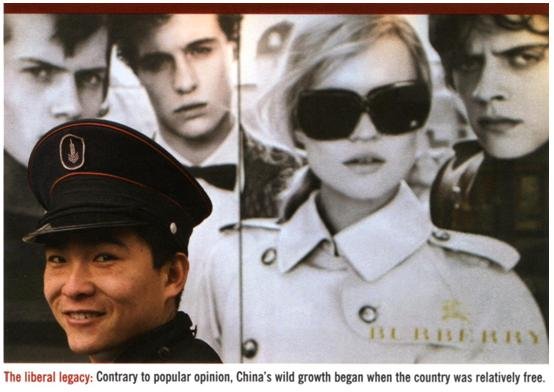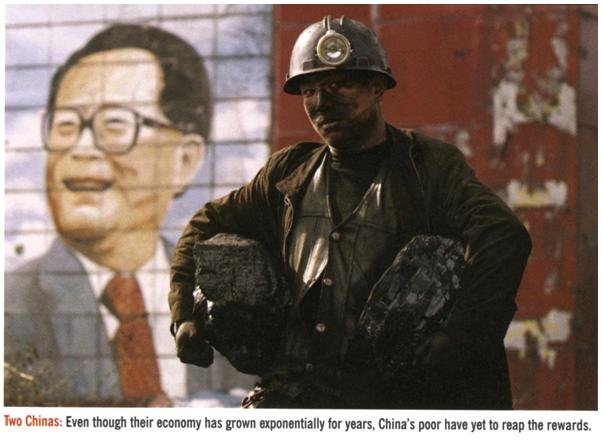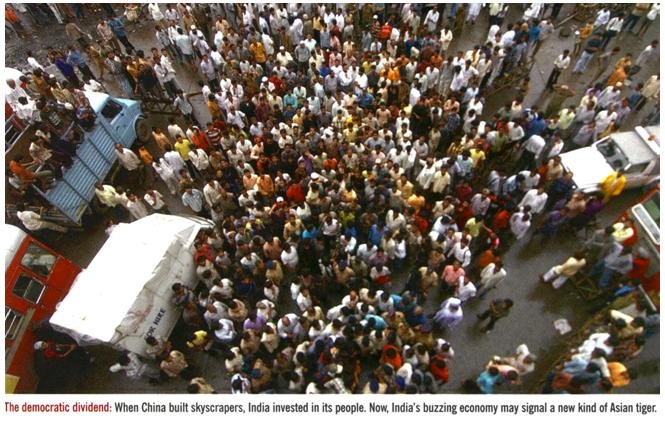Democracies are peaceful, representative and terrible at boosting an economy. Or at least that's the conventional wisdom in Asia, where for years growth in India's sprawling democracy has been humbled by China's efficient, state-led boom. But India's newfound economic success flips that notion on its head. Could it be that democracy is good for growth after all? If so, China better watch its back.
- By Yasheng Huang - Foreign Policy Magazine
Professor Yasheng Huang, of the Sloan School of Management at MIT, is author of Capitalism with Chinese Characteristics (New York: Cambridge University Press, 2008). He is writing a book on how politics shapes business, education, and entrepreneurship in China and India.

Consider the experiences of the following two Asian countries. In 1990, Country A had a per capita GDP of $317; Country B's stood at $461. By 2006, Country A, though 31 percent poorer than Country B only 16 years earlier, had caught up: It enjoyed a per capita GDP of $634, compared with Country B's $635. So, if you had to guess, which of these two Asian countries would you assume is a democracy?
You might be tempted to conclude that the better-performing country is authoritarian China and the laggard is democratic India. In reality, the faster-growing country is India, and the laggard is the occasionally autocratic Pakistan. This fact certainly belies the commonly held notion that—especially among Asian countries—authoritarian states have an advantage in growing an economy compared with their democratic counterparts, who are forced to reckon with such pesky trappings as labor standards and political compromises.
But surely, the familiar China-India comparison would support an authoritarian edge, right? The conclusion seems so obvious: China is authoritarian, and it has grown faster; India is democratic, and it has grown more slowly. For years, Indians have defended their democracy with a sheepish apology—"Yes, our growth rate is terrible, but low growth rates are an acceptable price to pay to govern a democracy as large and as diverse as India."
There is no need to apologize now India has ended the infamous 2 to 3 percent annual "Hindu rate" of growth and begun its own economic takeoff. Recent Indian success is not only impressive in terms of its speed growing at the "East Asian rate" of 8 to 9 percent a year but also in terms of its depth and breadth. The Indian miracle is no longer confined to the much vaunted information-technology sector; its manufacturing is taking off. Even the historically lackluster agricultural sector is beginning to grow.
So where does this leave the "authoritarian edge" that China's economy has supposedly enjoyed for years? The emerging Indian miracle should debunk—hopefully permanently—the entirely specious notion that democracy is bad for growth. And the emerging Indian miracle holds substantial implications for China's political future. As Chinese political elites mark the 30th anniversary of economic reforms this year, they should reflect on the Indian experience deeply and absorb the real reason behind their own miracle.
The idea that there is a trade-off between economics and politics is ingrained in the minds of many policymakers and business executives in Asia, as well as the West. But that idea has never been systematically proven. If India, with its noisy, chaotic, and lumbering political arrangements, can grow, then no other poor country must face a Faustian choice between growth and democracy. A deeper look at the two countries shows that they have succeeded and failed at different times for remarkably similar reasons. Their economies performed when their politics turned liberal; their performances faltered when their politics slid backward. Now, as many poor countries grapple with similar political and economic choices, we must understand this dynamic. It is high time to get the China-India story right.
That story doesn't begin in 2008. It's a horse race that goes back decades, and one that tells us much about the relationship between democracy and growth, governance and prosperity. From an economic perspective, it is not the static state of a political system that matters, but how it has evolved. The growth India enjoys today sped up in the 1990s as the country privatized TV stations, introduced political decentralization, and improved governance. And contrary to the conventional wisdom, India stagnated historically not because it was a democracy, but because, in the 1970s and 1980s, it was less democratic than it appeared. To understand just what is happening in India's economy today— and how it relates to the country's political system—we must travel as far back as the 1950s.
Many scholars blame India's first prime minister, Jawaharlal Nehru, for adopting a development strategy that caused India to stagnate from 1950 to 1990. But this view is unfair to Nehru, and it shifts the blame from the real culprit—Indira Gandhi, Nehru's daughter and prime minister during much of the period from 1966 to 1984. Nehru's commanding-heights approach was the reigning ideology in many developing countries, some of which, like South Korea, were quite successful. The issue is not how harmful Nehru's economic policies were, but why India intensified and persisted in this model when it was clearly not working. To answer this question we have to understand the lasting damage that Indira Gandhi inflicted on Indian democracy.
Patronage became her electoral strategy as she undermined a vital institution in a functioning democracy—the party system. Gandhi weakened the Congress Party, once a proud catalyst of the independence movement, by sidestepping many of its well-established procedures, reducing its grass-roots reach in the states, and appointing party officials rather than allowing rank-and-file members to elect them. The shriveling of the Congress Party meant that Gandhi had to use other means to get reelected: crushing political opposition, pandering to special interests, or offering political handouts.
The cumulative effect of Gandhi's actions is that the Indian political system, though still retaining some essential features of a democracy, became unaccountable, corrupt, and unhinged from the normal bench marks voters use to assess their leaders. In a functioning democracy, voters punish those politicians who fail to deliver at the ballot box. Not in India. Both the 1967 and 1971 reelections of the Congress Party followed a decline of per capita GDP the year before. It was not democracy that failed India; it was India that failed democracy.
The economic consequences of this period of illiberalism were long lasting. Because Gandhi's polite compulsion to invest in real drivers of economic growth—education and health. The ratio of teachers to primary-school students throughout the long Gandhi years stubbornly hovered around 2 percent. After her rule, in 1985, only 18 percent of Indian children were immunized against diphtheria, pertussis, and tetanus (DPT), and only 1 percent were immunized against measles. Even today, India is still paying for her neglect. The low level of human capital remains the single largest obstacle to that country's developmental prospects.
The good news is that India is shedding this harmful legacy. As Indian politics became more open and accountable, the post-Gandhi governments began to put welfare of the people at the top of the policy agenda. For example, the adult literacy rate increased from 49 percent in 1990 to 61 percent in 2006. In due time, these social investments will translate into real dividends.
CHINA'S GREAT REVERSAL
The story of China's rise seems, on the surface, quite different. A communist and closed regime undertakes an efficient, massive, and rapid embrace of the global economy—and sends its country into overdrive. It appears to be a far cry from the common understanding that democracy promotes growth because it imposes constraints on rulers and reassures private entrepreneurs of the safety of their assets and fruits of their labor. The idea that China grew because of its one-party rule stems from a mistaken focus on a single snapshot in time at the expense of an understanding of shifting trends. China did not take off because it was authoritarian. Rather, it took off because the liberal political reforms of the 1980s made the country less authoritarian. Like India, when China reversed its political reforms and saw governance worsen in the 1990s, citizens' wellbeing declined. Household income growth slowed, especially in the rural areas; inequality rose to an alarming level; and the gains of economic growth accruing to ordinary people fell sharply. China even underperformed in its traditional areas of strength: education and health. Adult illiteracy rose. Immunizations fell. The country's GDP might have been booming, but it was also hazardous to your health. The real Chinese miracle began back in the 1980s—when Chinese politics was most liberal. Personal income growth outpaced GDP growth; the labor share of GDP was rising; and income distribution initially improved. China accomplished far more in poverty reduction in the 1980s without any of the factors (such as foreign direct investment) now viewed as essential elements of the China model. In four short years (1980-84), China lifted more of its rural population out of poverty than in the 15 years from 1990 to 2005 combined. If India became less democratic under Indira Gandhi, China became less authoritarian under the troika rule of Deng Xiaoping, Hu Yaobang, and Zhao Ziyang in the 1980s. Therein lies the key insight into China's economic takeoff.
The real Chinese miracle began back in the 1980s—when Chinese politics was most liberal. Personal income growth outpaced GDP growth; the labor share of GDP was rising; and income distribution initially improved. China accomplished far more in poverty reduction in the 1980s without any of the factors (such as foreign direct investment) now viewed as essential elements of the China model. In four short years (1980-84), China lifted more of its rural population out of poverty than in the 15 years from 1990 to 2005 combined. If India became less democratic under Indira Gandhi, China became less authoritarian under the troika rule of Deng Xiaoping, Hu Yaobang, and Zhao Ziyang in the 1980s. Therein lies the key insight into China's economic takeoff.
One of the first acts by the reformist leaders was to signal an improving environment for private property. In marked contrast to today's massive land grabs, the Chinese government in 1979 returned confiscated bank deposits, bonds, gold, and private homes to those former "capitalists" the regime had persecuted. The number of people affected by this policy was not large, around 700,000. But symbolism mattered for a country still reeling from the Cultural Revolution. There were also other symbolic acts designed to elicit the confidence of private entrepreneurs in the new political environment of a post-Mao era. In 1979, two vice premiers visited and personally congratulated an entrepreneur who was granted the first license to operate a private restaurant in Beijing. As early as 1981, a Communist Party document signaled a willingness to recruit its members from the private sector, a well-publicized gesture. The widely held view that the party only began to recruit capitalists late in the Jiang Zemin era is simply incorrect.
The reformist leaders also began to embark on meaningful political changes. As scholar Minxin Pei has noted, every single important political reform— such as the mandatory retirement of government officials, the strengthening of the National People's Congress, legal reforms, experiments in rural self- government, and loosening control of civil society groups—was instituted in the 1980s. The Chinese media became freer in the early reform era. The timing here is critical. This "directional liberalism" of China's politics either preceded or accompanied China's economic growth. It was not a result of economic success.
This liberalism mattered the most for growth in rural China, where the majority of Chinese citizens live. Private access to capital eased in the 1980s. Private entrepreneurship and even some privatization became widespread, especially in poorer parts of the country that needed them most. Of 12 million rural businesses classified as township and village enterprises, 10 million were completely private. The change in direction of China's politics was sufficientlycredible to encourage millions of entrepreneurs to go into business for themselves.
But in the 1990s, the Chinese state completely reversed the gradualist political reforms that the leadership began in the 1980s. This assessment comes from a well-placed insider, Wu Min, a professor at the Party School under the Shanxi Provincial Party Committee. In a 2007 article, Wu revealed that the political reform program adopted at the 13th Party Congress in 1987 implemented some substantial changes. The congress abolished the party committees in many government agencies and explicitly delineated the functions of the party and the state. After 1989, there was no progress on the political reform front, especially in reducing and streamlining the power of the Communist Party.
The political reforms of the 1980s were designed to enhance the accountability of the government by creating some checks and balances over the power of the parry and by fostering intraparty democracy. Wu cites one specific measure in the 1990s to derail the reforms of the 1980s. According to Wu, in the 1990s China instituted explicit provisions prohibiting the National People's Congress (NPC) from conducting evaluations of officials in the executive branch and the courts. Wu comments, "This is obviously a step backward."
 Just how far did this step set back China? How about nearly 30 years? Consider China's track record when it comes to industrial fatalities. In 1979, in the aftermath of the capsizing of an oil rig that resulted in 72 deaths, the NPC held hearings at which officials in the Ministry of Petroleum Industry were called to testify. The minister was determined to have been negligent and was sacked. But since the mid-1990s, there have been hundreds of explosions and industrial accidents in China's coal mines. Thousands of people have lost their lives. No hearings have been held, and not a single official at the rank of minister or provincial governor has ever been held explicitly responsible.
Just how far did this step set back China? How about nearly 30 years? Consider China's track record when it comes to industrial fatalities. In 1979, in the aftermath of the capsizing of an oil rig that resulted in 72 deaths, the NPC held hearings at which officials in the Ministry of Petroleum Industry were called to testify. The minister was determined to have been negligent and was sacked. But since the mid-1990s, there have been hundreds of explosions and industrial accidents in China's coal mines. Thousands of people have lost their lives. No hearings have been held, and not a single official at the rank of minister or provincial governor has ever been held explicitly responsible.
Like Indira Gandhi in the 1970s and 1980s, the Chinese state greatly centralized its economic management in the 1990s. It was another reversal from the promising reforms of a decade earlier, the gist of which was delegating decision-making to those best informed about local situations. In 1994, the central government increased substantially the shares of tax revenues going to the central coffers and abolished one of the most innovative Chinese reforms—fiscal federalism. A less well-known development in the 1990s was that the Chinese state centralized the budgetary and other functions of villages. So, even though people were voting in village elections, the officials elected exercised very little power.
The economic consequences of these reversals were substantial. The 1990s saw depressed growth in household incomes relative to GDP, which means that the average Chinese person was losing ground. The employee share of GDP — the income going to the general population — peaked in 1990, at 53.5 percent. By 2002, it had declined to 45 percent of GDP. At 45 percent, the Chinese economy in 2002 was benefiting its people less than it was in 1978, when its employee share of GDP stood at 48 percent. Similarly threatening for the poorest Chinese is a development that has garnered almost no attention: The country is backsliding on literacy.
On April 2, 2007, the state-run China Daily published an article with an unusually frank title, "The ghost of illiteracy returns to haunt the country." It reported that the number of illiterateChinese adults increased by 30 million between 2000 and 2005. In 2005, there were 115.7 million illiterate Chinese adults, compared with 85 million in 2000. The roots of the problem began in the 1990s. Consider how literacy is defined—the ability to identify 1,500 Chinese characters by the age of 7 to 9. An adult reaching into the illiterate group by 2005 received all his or her primary education in the mid1990s. In addition, immunization rates against DPT and measles—rising throughout the 1980s—began to decline in the 1990s. In time, China will pay dearly for these colossal failures.
In the 1990s, the nature of China's growth was fundamentally altered. In the 1980s, growth was broad-based and positive for the poor; since then, the percentage of people benefiting from growth has narrowed, and social performance has deteriorated. The impact of this great reversal is strongest in the silent and less visible rural areas of China.
THE WAY TO REFORM
Of course, understanding the origins of India's and China's separate paths to development is just half the story. What's more telling is how these two countries enacted and reacted to reforms—and what that says about the relationship between political liberalization and economic growth.
After the Soviet collapse, Chinese political elites converged on the view that China avoided the same fate because China had not reformed its politics. The truth is precisely the opposite. The single most important reason why China survived the 1989 Tiananmen crisis is because its rural population was content. In the 1980s, rural China experienced the most radical economic and political reforms. It was reform that saved the Chinese Communist Party.

Political reforms contributed to Indian growth as well. Take the media. During the long Gandhi era, though the print media were free, the government controlled the TV stations—a more important source of information for a country with high illiteracy. The privatization of the stations in the 1990s not only enriched the quality of entertainment for the average Indian but also added transparency to Indian politics. Many corruption and bribery scandals were first exposed on TV, the effects of the exposures being magnified by the vivid images of politicians receiving cash in shady hotel rooms. That is the right way to fight corruption.
As China tightened its political grip on rural affairs in the wake of the Soviet collapse, India moved in the opposite direction. In 1992, India amended its constitution to strengthen a reform with long and deep implications-village self-government. This panchayati raj phenomenon promises to transform an urban- centered, elitist system to one that is Tocquevillian in character and is empowering women along the way. The auxiliary institutions of Indian democracy, so atrophied under Indira Gandhi, have been renewed. World Bank indicators show a notable improvement in key areas of Indian governance during the period of high growth since the mid-1990s.
In fact, India leads China in a number of important areas of reform. Throughout the 1990s, India reduced state controls on the banking sector, allowed the entry of private domestic and foreign banks, and abolished government interference in setting the equity pricing of initial public offerings on the stock exchange. China is nowhere near India in terms of pace and depth of financial reforms.
Would democracy galvanize opposition to reforms? Many progressive reformers in China hold this view, but this is a hypothesis long on fear and short on facts and other networks overnight. Surely, authoritarianism has an edge when it comes to public works projects. But no. Building infrastructure has followed-not preceded-Chinese growth. In 1988, China had roughly 91 miles of expressway. That did not begin to change until the late 1990s, when the country poured massive resources into infrastructure. Only in the past eight to 10 years could the country claim to have infrastructure rivaling that of developed countries.
Many foreign investors think that infrastructure explains the different pace of growth between China and India. No such evidence exists. In the 1980s, India started with some infrastructural advantages over China. It had a longer system of railways, for example. Although we can debate today which country is performing better, there is no doubt that China outperformed India in the 1980s. It was reforms and social investments that propelled Chinese growth, not fancy airports and skyscrapers.
One justification for building those massive infrastructure networks is to attract FDI. For years, Western economists and business analysts have chided India for not following the policy business is how to grow the economy—not how to attract FDI. As long as India can grow in the 8 to 9 percent range, even without superior infrastructure, it can easily triple or even quadruple its FDI inflows from its current level of $7 billion a year. Growth can self-finance the infrastructure truly needed for business and economic development.
China has built critical networks, such as power stations and transportation links, but since the mid-1990s, unconstrained by public voice, media scrutiny, and private land rights, Chinese leaders have wasted massive resources on urban skyscrapers that have no economic benefits. Many of them are government buildings and are extraordinarily expensive, costing more than $100 million in some cases. And the financial costs of these projects do not even begin to approach their opportunity costs—those investments in education and health China has failed to make. That a country constructed nearly 3,000 skyscrapers in Shanghai and added 30 million illiterate Chinese during the same decade is truly remarkable.
The economic dividends of political reform don't appear overnight, which skews the timeline and confuses the cause. But by using nearly every metric, political liberalization has spurred rather than stunted growth in both China and India.
After a long hiatus, China's leadership has rhetorically returned to a vision of the 1980s—that political reforms should be a priority. Rural China has begun to recover from the neglect of the 1990s, and rural income has grown the fastest since 1989.
All this is good news. But consolidating these achievements will require a more substantial undoing of the illiberal policies of the 1990s. How India managed to emerge from its own long shadow of illiberalism offers some valuable lessons. In the past, China taught India the importance of social investments and economic opening. It is time for today's China to take a page from India—and from the China of the 1980s—that political reforms are not antithetical to growth. They are the keys to a healthier and more sustainable foundation for the future.
